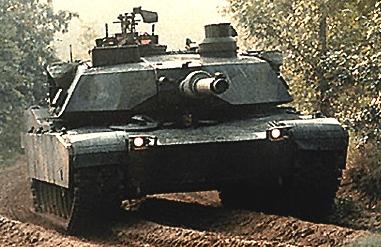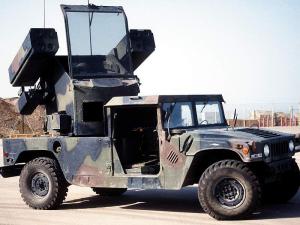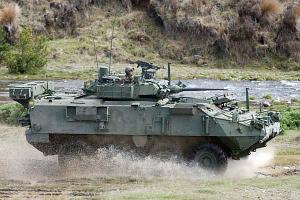Real-life Armour
The armoured vehicle first appeared on the battlefield in the form of the mounted knight, but in modern times it is exemplified by the main battle tank. These massive, heavily armed vehicles are often considered the very symbol of military might on the ground, just as the nuclear-powered aircraft carrier is considered the symbol of military might at sea. But the main battle tank is but one form of armoured vehicle, and there are many other types of armoured vehicle which, while lacking the glamour of the main battle tank, are still nevertheless essential to a modern army. A few of these categories are listed here, although you should keep in mind that this is merely a very brief overview of category types, not a comprehensive listing.
Tanks
 The
first WW1 tanks were used for the purpose of breaching defensive
lines, in a variation upon the ancient cavalry charge. The tanks
would create a hole in the lines through a massed attack, and the
infantry would pour through. However, no weapon exists for long
without a countermeasure appearing, and the tank was no exception.
After the initial shock, armies quickly developed various ways of
countering the tank, so it could no longer roll up to defense lines
with impunity. The Germans quickly realized that the way to counter
the growing power of anti-tank weaponry was to reverse the roles of
the tank and the rest of the army. Instead of using the tank merely
to punch a hole through enemy lines, they realized that the tank
could be used to exploit a hole through enemy lines. In WW2,
they used this realization to great effect, by creating a breach with
infantry, artillery and aircraft, and then sending their tanks
through the hole. With their great mobility and power, the armoured
divisions could disrupt supply lines, hit supply depots, attack
headquarters, cut communications, and generally sow confusion in the
enemy's rear. This is the so-called "mobile warfare"
doctrine, and it has been a mainstay of military strategy ever since.
The
first WW1 tanks were used for the purpose of breaching defensive
lines, in a variation upon the ancient cavalry charge. The tanks
would create a hole in the lines through a massed attack, and the
infantry would pour through. However, no weapon exists for long
without a countermeasure appearing, and the tank was no exception.
After the initial shock, armies quickly developed various ways of
countering the tank, so it could no longer roll up to defense lines
with impunity. The Germans quickly realized that the way to counter
the growing power of anti-tank weaponry was to reverse the roles of
the tank and the rest of the army. Instead of using the tank merely
to punch a hole through enemy lines, they realized that the tank
could be used to exploit a hole through enemy lines. In WW2,
they used this realization to great effect, by creating a breach with
infantry, artillery and aircraft, and then sending their tanks
through the hole. With their great mobility and power, the armoured
divisions could disrupt supply lines, hit supply depots, attack
headquarters, cut communications, and generally sow confusion in the
enemy's rear. This is the so-called "mobile warfare"
doctrine, and it has been a mainstay of military strategy ever since.
However, tank warfare is not without its weaknesses. Mobile warfare carries with it a great burden in terms of logistics; the tanks require prodigious supplies of ammunition, parts, and particularly fuel in order to conduct their operations, and an armoured thrust into enemy territory can only reach so far before its logistical train becomes impractical and vulnerable. The weapon of a tank, while very powerful, is no substitute for the big guns of field artillery. Furthermore, modern anti-tank weapons are so light and effective that two men in a jeep are fully capable of destroying even a main battle tank, provided they can get close enough. This limits the usefulness of tanks to terrain which is open and flat, like the broad plains of northern France or the deserts of North Africa. In any other environment, tanks must be supported closely by infantry and artillery or they will take unacceptable losses, and in some cases, the tanks may even be relegated to a supporting role. Even in open terrain like the deserts of North Africa, history shows us that the victor is usually the combatant who best combines his tanks with artillery and infantry (Rommel's innovative use of his 88mm guns being an obvious example). In other words, the strength and power of the tank is impressive, but not so great that it removes the need for combined-arms tactics.
A modern main battle tank (MBT) is a marvel of technology. The M1A1 Abrams pictured here weighs in at more than 60 tons, and its gas turbine powerplant produces more than 1500 horsepower. It can propel its enormous bulk down the road at 67 km/h, and its 120mm smoothbore cannon makes the tank guns of WW2 look like popguns. It has all the usual toys, such as infrared and night-sight viewing for its crew and computer-assisted targeting against both stationary and mobile targets, it is capable of firing on the move, and of course, it incorporates the strongest armour that can be mounted onto its frame.
However, MBTs are expensive, and with the collapse of the Soviet threat, the need for vast armies of MBTs no longer exists. Light tanks such as the American Stingray, Austrian SK-105, or French AMX-13 sport a 105mm or 90mm gun and light armour plate, so they pack most of the punch of a main battle tank but little of its armour. Some versions are even amphibious, for extra flexibility. Vehicles like this would not survive for long in battle against MBTs in force, but they are inexpensive, they can be easily transported via aircraft, and they are more than capable of defending themselves against the less heavily armed opponents that are likely to typify asymmetrical, low-intensity combat in the post-Cold War era.
 Reconnaissance Vehicles
Reconnaissance Vehicles
It is tempting to believe that satellites, lasers, and infrared cameras on aircraft make old fashioned reconaissance unnecessary, but this is simply not the case. Inclement weather can render satellites and aircraft useless, and ground armies have many ways of concealing their resources from the flying, spying eyes of the air force. There is still no substitute for a man on the ground, and that man will need a vehicle appropriate for the job. Recon vehicles can be considered the next step below light tanks, and they usually take the form of armoured cars. They are even lighter and faster than light tanks, often being capable of exceeding 100 km/h. Their wheeled construction makes them much cheaper to build and operate, and they can range from vehicles which pack the punch of a light tank (such as the French AMX-10RC which has a 105mm cannon) to lightly armed amphibious vehicles such as the German Spähpanzer Luchs and even overgrown jeeps like the American Humvee. In all cases, each design represents a different compromise between cost, flexibility, speed, and survivability.
 Mobile Infantry Combat Vehicles
Mobile Infantry Combat Vehicles
The MICV (also known as the APC, or armoured personnel carrier, and IFV, or infantry fighting vehicle, and LAV, or light armoured vehicle, among other monikers) is an armoured vehicle which has been designed to carry infantry to the site of battle. Mobile warfare requires much more speed than men on foot can possibly possess, and there is a need to bring men to the battle while providing a measure of protection superior to what a scout vehicle like a Humvee could provide. The APC has evolved greatly from its humble origins as a mere "infantry taxi", and its purpose is now to not only ferry the infantry to the site of battle, but also to support the infantry once there. To that end, modern APCs usually incorporate weapons such as missile launchers, mortars, grenade launchers, or heavy machine guns. For example, the American M2 Bradley provides complete protection from small-arms fire, it has a 25mm chain gun, a 7.62mm machine gun, and a pair of anti-tank missile launchers. Other APCs may have heavier or lighter weapons (20mm guns are popular), smoke canisters, and in some cases, they may even have powered gun turrets (the American Dragoon can be equipped with a 90mm gun, but at the expense of cargo capacity, thus detracting from its primary purpose). Both tracked and wheeled configurations are available, although wheeled APCs seem to be more popular because of their reduced cost and superior speed. Many APCs are amphibious, and some specialized "over-snow" variants also exist.